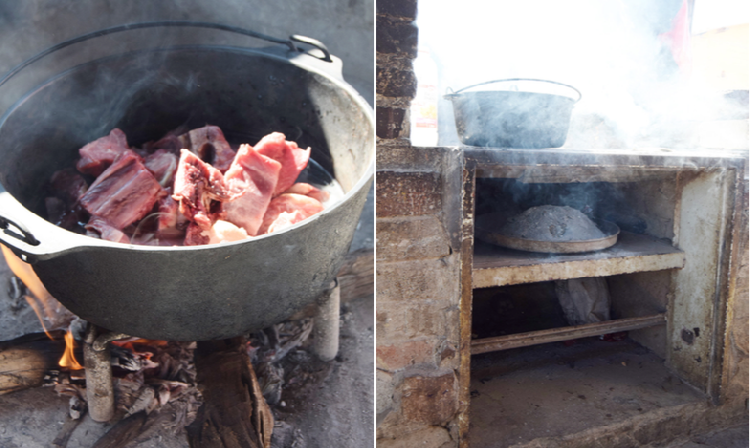Proponent of black nationalism Marcus Garvey once said: “A people without the knowledge of their past history, origin and culture is like a tree without roots”.
And just like a tree without roots, you will embody instability if you don’t know yourself and where you come from. This message was conveyed during the week long road trip, My Culture My Life with Sanlam during which I met two prominent Damara leaders at Otjimbingwe recently.
The long ride from Windhoek is tiresome and as we entered a small town in the Erongo region, little did I know how much knowledge I would gain there.
Otjimbingwe – at first glance a quiet little town with dusty streets, under-privileged residents and not too much going on. I admit I wasn’t too excited to be there at first.
Not long after our arrival, we were escorted to small, humble home made of zinc where two elderly, smartly dressed men sat in conversation in the shade provided by the shack. Speaking in Khoekhoegowab, they didn’t say too much as we approached, however you could feel the atmosphere change. We weren’t in any ordinary person’s yard. It was clear that deeply rooted culture and profound knowledge lived here.
As the film crew set themselves up, Damara artists Kalux and Female Donkey took their seats next to the two debonaire men. The first introduced himself. “I am Jonathan Neumbo,” he said, adding that he was advisor to the office of the chief. The second one introduced himself as deputy chief Joshua Seibeb. Seibeb was on duty to deal with matters at hand as the chief was not available on account of personal business.
After a short conversation between the two leaders and the artists, Female Donkey enquired how they came to be selected as leaders. Neumbo spoke first. He explained that the different clans of the Damara have their own procedures for electing leaders, and that he would only speak about the clan in that particular area – the Swakopmund River Damaras of Otjimbingwe.
Neumbo explained that although there may be many chiefs among the Damara clans, they all follow one man – King Justus Garoeb. Much controversy surrounds the king, as under Namibian law he is not recognised as a traditional leader. This does not deter the Damaras from recognising him as their rightful king, though.
Neumbo further explained that the Garoeb line is royal blood, and the elected king is always older than 30 years, and displays true characteristics of a leader. Neumbo added that the king would be already busy grooming a young man to take over his position once he passes away and only the king’s closest confidants know who the next on the throne will be.
The deputy chief, Seibeb, took over the conversation. In a soft and humble tone, Seibeb explained that when a young man is elected to take up a leadership role in the council, he is brought to the kingdom, where he would undergo vigorous tests and tasks to determine whether he is truly worthy to lead.
Seibeb continued the conversation, moving on to a discussion about Damara traditions for weddings. The deputy chief said that unlike modern-day culture, young men did not find a young woman they liked and proposed to her back then. No. It was the family’s job to do the courting for the couple.
Once the elders and sisters of the groom had picked a young woman they found fit to welcome into the family, the proposing would take place, after which the couple would engage in matrimony. The bride-to-be would already have been prepared to carry out her ‘wifely’ duties.
He further explained that once the couple were married, they would be sent away with livestock in order to start their new lives. Seibeb mentioned that is why there are so many different groups found scattered across the country.
The deputy chief added there are 18 Damara groups, with different clans amongst them which amount to approximately 32.
After listening attentively, Kalux enquired as to what the traditional attire was at these wedding ceremonies. Instead of answering his question directly, Neumbo elaborated on Damara attire in general.
Neumbo said that before the days of the missionaries, the Damaras only wore green. In the times of many challenges, the green represented awareness – to be expectant of all challenges that may lie ahead. He added that a man, out of respect, always wears a hat unless he is eating.
Seibeb continued the story, expanding to the three main colours in the Damara traditional attire – blue, green and white. He told a story from many years ago. “Originally, the Damaras wore green,” he reiterated. However many years ago, the clans were transporting the tombstone of a late king to the traditional Okombahe festival and during the preparation of this festival, another unfortunate event occurred. While preparing for the event, the queen to the late king suddenly collapsed and died.
When the different clans then gathered at the festival, one particular clan arrived with a blue flag. In honour of the queen and king, the blue and green clan had a symbolic battle to unify the colours. However, blue and green being two dominant colours, the clans incorporated white as a third colour to signify peace amongst the different clans.
Female Donkey, quite interested by the discussion at hand, couldn’t resist diving deeper into the history of her culture and questioned the two elders about traditions surrounding death. Seibeb, this time leading the conversation, explained that death is something that happens in the blink of an eye and that children were not allowed to view any body, or attend a burial.
“During those days, the men made the coffins themselves, and the coffin was then transported by wagon,” he mentioned. The children could also not watch the wagon and had to look away if it passed them. This still applies to this day.
The man of the house in which the death occurred would make all the important decisions surrounding the burial. When a cow is slaughtered at a funeral, it wasn’t chopped up as usual, but would rather just be cut at the joints as this is not a celebration. The bones of the carcass would also not be thrown away as usual, but would be discarded in the same manner as a burial. The same would happen with the ashes from the fire used to cook the food, Seibeb said.
Seibeb mentioned that in those days it was an honour for the husband to decide where his wife was to be buried.
Before explaining the importance of the knowledge of culture, Seibeb debunked some of the misconceptions surrounding the Damara culture. He mentioned that although donkey meat is highly associated with the tribe, this is a relatively new custom, and that Damaras used to hunt in the veld and ate fruits and vegetables they scavenged for.
“The children now are confused, because of the western way of doing things,” Seibeb said. “If you don’t know your culture, you are not a Damara,” the deputy chief said sharply. “You don’t know where you are from and where you are going – you are lost.”
Stay informed with The Namibian – your source for credible journalism. Get in-depth reporting and opinions for
only N$85 a month. Invest in journalism, invest in democracy –
Subscribe Now!








